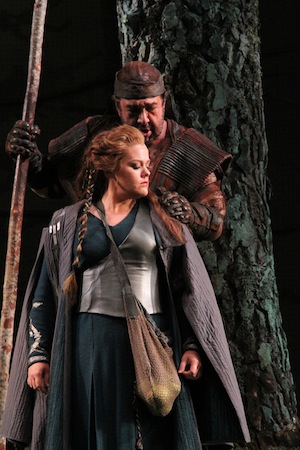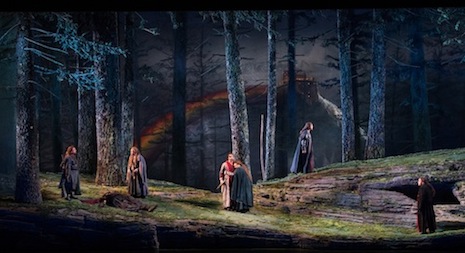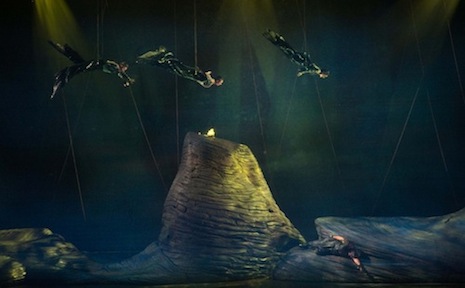 This summer, I became slightly obsessed with the Ring. Not the J.R.R. Tolkien trilogy, not the Japanese horror movie (which I have vowed never to see), but the epic four-opera series by Richard Wagner. Der Ring des Nibelungen spans about 17 hours and features a cast of gods, dwarves, giants, mermaids, and a dragon, all vying for control of a powerful golden trinket.
This summer, I became slightly obsessed with the Ring. Not the J.R.R. Tolkien trilogy, not the Japanese horror movie (which I have vowed never to see), but the epic four-opera series by Richard Wagner. Der Ring des Nibelungen spans about 17 hours and features a cast of gods, dwarves, giants, mermaids, and a dragon, all vying for control of a powerful golden trinket.
I’d mainly seen comic operas before, and I wasn’t sure I would like Wagner’s heavy style. But when I heard that Seattle Opera was staging its famous “green” Ring, with sets modeled after the scenery of the Pacific Northwest, I decided that I had to go.
So on the evening of August 12, I dressed up, limited my fluid intake, and headed downtown to see Das Rheingold, the first opera in the cycle. The pre-show buzz in the concert hall was thrilling. The singing (to my untrained ear) was glorious. The dialogue was unexpectedly funny.
But the most impressive moment was the transformation from the first to the second scene, when the curtain closes on an underwater vision of the Rhine River, mermaids twirling above the rocks, and opens just moments later on a FOREST. A real, honest-to-God forest.

Okay, it wasn’t a real forest. But it sure looked convincing. A rocky ridge rose on the right side of the stage. Pines towered over the landscape. And everything, from the tree bark to the scattered patches of grass, appeared to have been plucked from the Washington wilderness into McCaw Hall.
I had to find out how the opera staff had pulled it off, so I called Michael Moore, Seattle Opera’s scenic studios manager.
First of all, he told me, the trees are not stationed in the wings as I had imagined. They are hanging high above the stage, out of sight, like Santa Claus waiting to come down the chimney. When the curtain drops, “you have perhaps 90 seconds to remove the Rhine River in its entirety and replace it with an entire forest,” says Moore. The rocky river bottom slides offstage, and the grassy terrain slides on. At the same time, trees descend from above and lock into trunk-sized divots on the ground.

Because the trees are controlled by a system of cables and counterweights, they can’t be very heavy. So Moore, who also works as a pilot, looked to lightweight aircraft technology for inspiration. (One of his jobs is towing banners: “I propose marriage to half a dozen women in a typical year. Along with happy birthdays and occasionally the GEICO lizard.”) To create each trunk, his team made thin aluminum cross-sections and connected them with aluminum tubes. These airy columns were covered with Dacron fabric. Then plastic, moulded to resemble bark, was layered on top, along with some foam, sawdust, and aluminum twigs for good measure.
I asked Moore if he was afraid that one of the singers would lean a bit too hard on a pine and knock it loose. Nope, he said. Or what if a tree fell onto a swimming Rhinemaiden? Not gonna happen, he said. “The business of creating stage scenery is a profession,” he says. “And we avoid disaster.”
Image credits
First photo © Alan Alabastro
Second and third photos © Elise Bakketun